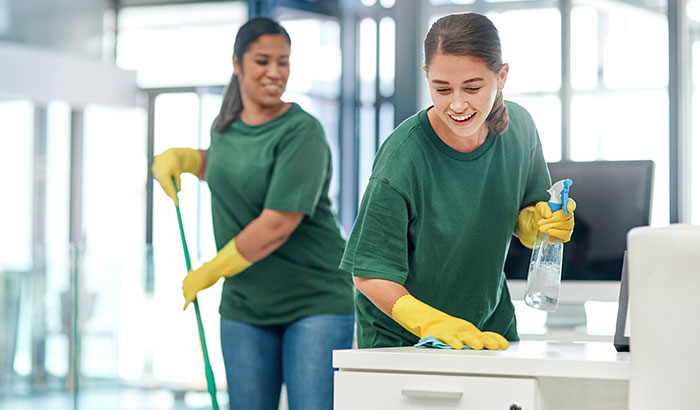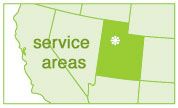Even with regular cleaning tasks that you do every day or every week, some parts of your home require occasional deep cleaning to keep your space sparkling. But how do you remember what needs to be cleaned, how often it needs to be cleaned, and how to clean it? And where do you start?
Deep cleaning can feel a bit overwhelming, but we’ve got you covered with a list of 10 steps to properly deep clean your home from top to bottom and get the job done right.
You want to ensure you are focusing on actually deep cleaning and not spending too much time and energy on other tasks that might be more suitable for a different time before or after a deep cleaning.
So what’s the difference between regular cleaning and deep cleaning? Well, deep cleaning usually builds on the cleaning tasks you do regularly, but goes a bit further and deeper in what is cleaned and how. For example, vacuuming and sweeping are considered regular cleaning, but shampooing the carpet and steam cleaning hard flooring are examples of deep cleaning.
You can always hire professional cleaners to take care of the deep cleaning if it’s not something you want to tackle yourself. Deep cleaning requires a bit more time and effort, but the benefits are worth all the extra energy whether you do it yourself.
We are continuing our list we began in part 1 with the next five steps to properly deep clean your home.
6. Baseboards
Baseboards are the wooden or vinyl slats that cover the joint where the wall meets the floor, and no deep cleaning of your home is complete without spending some time and a bit of elbow grease on the baseboards.
These small ledges can quickly collect dirt, dust, and grime. And even though the floors in front of the baseboards are usually swept or vacuumed, the baseboards are often overlooked. The good news is that cleaning the baseboards can be a quick and easy process that will make your home look and feel pristine.
Simply vacuum up the dust using a narrow attachment on your vacuum, or wipe the dust away with a damp cloth. For stubborn nooks and crannies, use a mild cleaning solution and cotton swabs or the corner of the cloth to wipe the crevices that are a bit harder to reach.
For extra protection, use a dryer sheet to rub over the dry baseboards to prevent dust from clinging to the baseboards via static.
7. Floors
If you followed our tips from part 1, you cleaned from the top of the room to the bottom and are ready to eliminate the last of any gunk left in your home. Deep cleaning your floors starts with sweeping and vacuuming up any crumbs or dust that may be present. The next step will depend on the type of flooring but will most likely include warm water and a cleaning solution.
Mix a small amount of cleaning solution that includes castile soap in a spray bottle with warm water for hardwood floors. It’s important to use the right mop for each surface, and microfiber mops are great for hardwood floors since microfiber helps to limit the amount of water left on the floor, thus preventing water damage or warping after mopping.
Avoid using cleaners that include acidic ingredients like ammonia for laminate, tile, and linoleum floors. These cleaners can leave a layer of harsh chemicals that can damage your floors.
Deep cleaning carpet includes spot cleaning any stains and using a carpet shampooer or a dry cleaning product that you can vacuum after absorbing dirt and odors.
8. Disinfect
The CDC provides recommendations for disinfecting your home and clarifies the difference between disinfecting and sanitizing. While sanitizing means eliminating bacteria on a surface, disinfecting goes a bit further by killing viruses in addition to bacteria. It’s important to know which products are designed for which purpose.
You may not want to use a strong disinfectant on the surfaces of your home every single day, but it can be a good idea to disinfect commonly used and touched surfaces when you are deep cleaning your home. This can prevent viruses and other illnesses from spreading to your family, so it is vital to disinfect during cold and flu season or when someone in your home has been ill.
9. Organize
Deep cleaning your home provides an excellent opportunity to organize your home to improve both function and aesthetics. This may require adding organizational containers or repurposing space to fill a different need. When your home is organized, it is easier to maintain cleanliness on a day-to-day basis.
10. Freshen Furniture
The last step on our deep cleaning to-do list is to freshen up your furniture. This means wiping down hard surfaces like coffee tables or shelving units. It can also include using baking soda or dry carpet cleaner to eliminate odors and stains that you might overlook daily.
This is especially true of couches and mattresses. Spread baking soda on the surface of your couch and mattress — you can even rub the baking soda into the upholstery with a gloved hand — and leave it to sit for about 30 minutes. Baking soda will absorb odors and any extra moisture. After 30 minutes, vacuum up the baking soda using a vacuum cleaner with strong suction and an upholstery attachment.
If any minor stains remain, use an upholstery cleaner and a soft brush or cloth to work the stain out and vacuum again to ensure it dries completely.
Daisy Maids Will Deep Clean Your Home for You
If you are looking for a little extra help keeping your home clean, call Daisy Maids! Unlike many other cleaning services, we charge by the job, not by the hour, and we are committed to getting the job done right the first time. Our 100% satisfaction guarantee means if you report an issue within 24 hours of the service, we will return and make it right.
With over 15 years of experience, Daisy Maids offers licensed and insured house cleaning services by a team of professionals. We offer deep cleaning, move-in/out cleanings, and regular cleaning services as often as you desire.
Get an estimate for your customized deep cleaning today!





